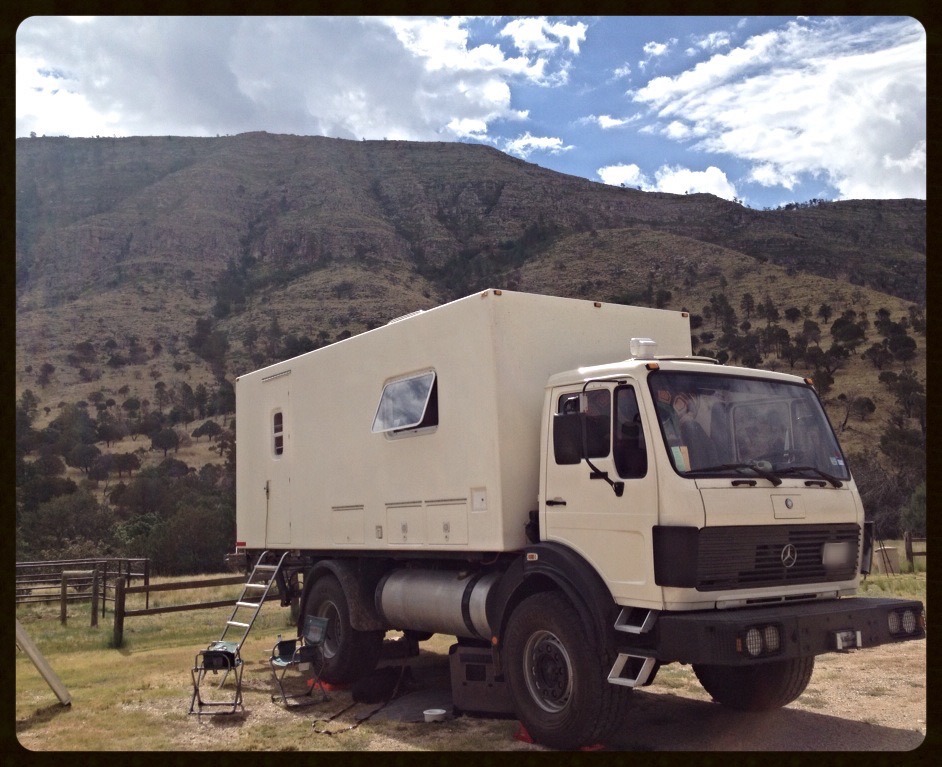What is it? Is it a UNIMOG?

The Texas Tortuga at Guadalupe Mountains National Park (Dog Canyon)
No, it’s not a Unimog. It’s just a little Texas camper. It’s the Texas Tortuga truck.
Traveling down the highway it is amazing to see the big smiles and sense of bewilderment when people see the Tortuga. Thumbs up as they pass on the highway. Groups of people gathering at stops. The most common comments are, “COOL TRUCK! What is it? Is it a Unimog? Did I see this truck on Extreme RV?”
The Texas Tortuga is a great truck and it never gets old to talk about past, present and future adventures in her. But, for those of you that could not catch up with the Texas Tortuga in person or didn’t want to ask, here is a little background on this great adventure vehicle.
History
The truck chassis is based on a 1988 Mercedes 1017A. (A 10 Ton military truck that has a 6 cylinder small turbocharged diesel engine.)
At least three of these vehicles were sent over to the United States and competed for the 10-ton vehicle contract for the Army in the late 80s. Mercedes did not win, but these vehicles were left in the States. In the early 2000s, three vehicles were released from military control with some changing hands several times. All three have now been made into expedition vehicles, i.e. custom 4×4 campers. These trucks are all over the world, but not in the United States.
The Texas Tortuga was the brainchild of Tom Boekbinder and built by an east coast yacht builder, Ed Smyth. The quality of work and the integration of systems is unparalleled. They built a world class expedition vehicle, with the ability to go where no normal RV has gone before.
Systems
This truck is ideal for visiting remote areas, anywhere in the world, due to its ability to burn any kind of diesel, including Biodiesel or vegetable oils. The other property of this truck for unworried remote travel is that it has no engine electronics. It is easy to repair with simple tools. And there is little to break down.
This truck is larger and way more comfortable to ride in than a Unimog, and is nearly as good off road. This is due to four wheel drive, locking rear differential, and what is called “gelandgangiges untersetzung,” a Mercedes-designed system of isolating the truck frame from the cargo/camper frame. This means that when off road, the truck frame can twist and bend, keeping all four wheels in ground contact, while not transferring the twist into the camper box.
The systems are what sets these trucks apart:
- Manual 5 speed transmission with 2 speed transfer case;
- Air over hydraulic drum brakes;
- Pressurized air system that operates brakes, differential locks and transfer case and allows the user to drop tire pressures for sand travel, and air up in minutes on the trail;
- Winches front and back (16,500 lbs., 24 volt, waterproof);
- German super-single wheels with brand new 44″ tall Continental On/Off road tires;
- Upgraded fuel tank with 100 gallon capacity;
- Lights converted to 24 volt LED, most military grade (can handle shock, vibration and water immersion);
- Less than 18,000 miles on the odometer at the start of 2016;
- Tight-turning 143” Wheelbase (Ford F 350, LWB Crew Cab1 is 172.4″);
- 10,500 lb. front axle;
- 17,160 lb rear axle;
- 26,840 lb. GVW (ample to carry out the function of well equipped and supplied expedition vehicle);
- 6 cylinder, inline turbo-diesel OM 352 A V, 5675 cc, 364 ci, 24 volt negative ground, 168 hp;
- Entire truck frame coated in spray-on truck bed liner;
- Remote operated, 24v search lights on top of cab and on top of rear camper box;
- Front bumper extended to conceal winch mounting and to house storage compartments for tools, chains and an air over hydraulic jack;
- Cab painted in aircraft quality Imron paint;
- Rear view camera along with a Sony stereo and Tomtom GPS in the cab;
- Cab currently set up for two adults and a dog, could easily handle three adults for long-term travel; and
- Air Conditioner added to Cab.
Camper Box
The body of this expedition vehicle has been built by a small, custom, boat builder. The construction techniques are similar to boat building ones.
The Camper box is 18 feet long and 8 feet wide. Due to some surprising innovations, it’s very comfortable and roomy for its size.
- All components are marine Grade for safety and durability. The main camper box is constructed of foam/fiberglass panels, no metal is used for maximum thermal efficiency.
- The camper frame is torsionally isolated from the truck frame, and additionally suspended by rubber springs.
- The galley, with 6 feet of counter space, is fully equipped with marine grade 2 burner electric cook top.
- There is a good sized bathroom with a separate shower, toilet, and vanity, with a marine toilet by Sealand, featuring an integrated black water tank.
- Isotherm full size fridge/freezer
- Splendide washer/dryer combo
- The main king-sized bed is suspended near the ceiling over theopen concept living area during the day, and lowered electrically for sleeping at night.
- Heating is provided by an Aquahot diesel-fired system. This provides space heating hydronically, hot water in unlimited quantities, and engine heating when preheat is needed in cold climates.
- Nearly 100 gallons of fresh water.
- Power is supplied by the engine alternator, an Onan Quiet Diesel 3200 watt generator, and shore power when available. With abundant battery bank and electronics, off grid living is possible for extended period.
- Outdoor hot and cold water shower.